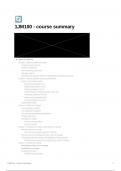Samenvatting
Extended Summary: Management of Organizational Change and Innovation (1JM100)
- Vak
- Instelling
This is an extended summary of all lectures for the course Management of Organizational Change and Innovation (1JM100). This 46-page document (with a clickable table of contents for easier navigation) summarizes the essence of all topics covered in the course (as far as I could imagine when writing...
[Meer zien]




